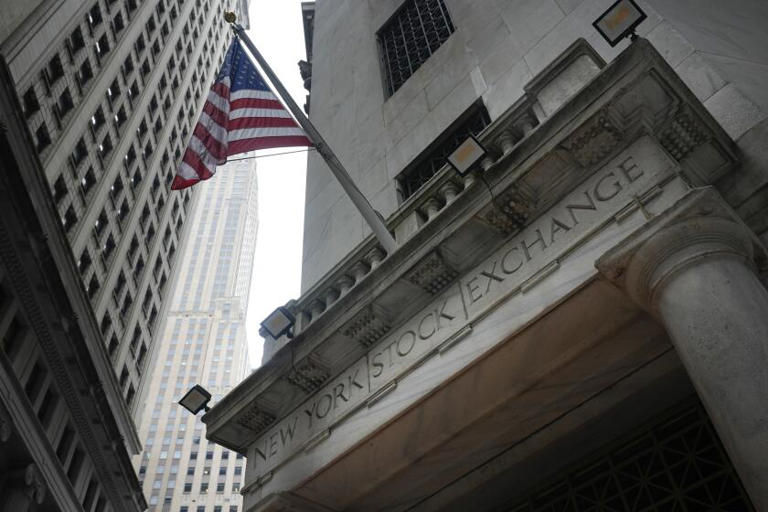The latest trading week on Wall Street concluded with further gains, propelling U.S. stocks to unprecedented heights across major indices. The Standard & Poor’s 500 (S&P 500) surged by 40.81 points, marking a 0.8% increase, and reaching a new pinnacle at 5,137.08, following its previous record-setting performance. This remarkable upward trajectory has been a recurring theme, with the S&P 500 climbing in 16 out of the last 18 weeks, buoyed by optimism surrounding moderating inflationary pressures and the resilience of the U.S. economy.
Simultaneously, the Dow Jones industrial average ascended by 90.99 points, representing a 0.2% gain, to reach 39,087.38. Notably, technology stocks took center stage, driving market momentum, as evidenced by the Nasdaq composite’s robust surge of 183.02 points, equivalent to a 1.1% increase, reaching 16,274.94, thereby surpassing its previous 2021 record.
In the bond market, Treasury yields experienced a decline subsequent to softer-than-expected reports on manufacturing activity and consumer sentiment within the United States. These developments reinforced market expectations of a potential interest rate cut by the Federal Reserve as early as June, particularly in light of a recent report indicating inflationary measures largely in line with projections for the previous month.
Dell Technologies emerged as a significant contributor to the market’s positive performance, with its stock soaring by an impressive 31.6%. The company reported stronger-than-anticipated profit and revenue figures for the latest quarter, underscoring robust demand for its AI-optimized servers amid a sustained surge in demand for artificial intelligence technology.
The tech sector’s momentum persisted with NetApp witnessing an 18.2% leap after exceeding earnings expectations and citing favorable momentum in AI-related initiatives. Additionally, the company provided a profit forecast for the current quarter that surpassed analyst estimates, further bolstering investor confidence.
Conversely, the banking sector experienced a downturn, exemplified by New York Community Bancorp’s significant decline of 25.9%. The company issued a warning to investors regarding weaknesses in its internal loan review processes, attributing the shortcomings to ineffective oversight, risk assessment, and monitoring practices. Consequently, the company announced a delay in filing its annual report and disclosed a $2.4 billion charge against its financial results for the final quarter of 2023. Furthermore, the chief executive officer announced immediate resignation after 27 years with the company.
The banking industry’s challenges have garnered considerable attention, particularly following the industry’s turmoil last year, which led to the collapse of several smaller regional banks. This includes the absorption of Signature Bank by NYCB, resulting in heightened regulatory scrutiny and loan-related struggles, particularly within the real estate sector.
While New York Community Bancorp (NYCB) grapples with its specific challenges, the broader banking industry faces mounting pressure stemming from loans extended for real estate projects. The Federal Reserve’s decision to raise its main interest rate to its highest level since 2001 has intensified this pressure, potentially straining the financial system. Consequently, there have been hopes for multiple interest rate cuts by the Fed throughout the year to alleviate the strain on banks and stimulate the broader economy.
The possibility of interest rate cuts hinges on the trajectory of inflation, with the Fed signaling its readiness to act decisively if inflation cools toward its 2% target. However, a series of robust economic reports have prompted traders to push back expectations for the timing of rate cuts. Initially anticipated for March, expectations for rate cuts have been deferred, with June now emerging as a potential starting point.
The prospect of a June rate cut gained traction following a report revealing a continued contraction in the U.S. manufacturing sector for the 16th consecutive month. Manufacturing, a key economic indicator, has lagged behind other sectors, although a resilient job market and robust consumer spending have provided some support. Moreover, a report on U.S. consumer sentiment falling below economists’ expectations added to the narrative of a potentially slowing economy.
In response to these reports, Treasury yields retreated, with the 10-year Treasury yield declining to 4.18% from 4.25%, and the two-year Treasury yield, a closely watched gauge of Fed rate expectations, dropping to 4.53% from 4.62%.
Economists at Deutsche Bank foresee the Fed cutting its main interest rate by 1 percentage point this year, bringing it down from the current range of 5.25% to 5.50%. Similarly, market participants anticipate a commencement of rate cuts in June. However, caution prevails, as there are concerns that the anticipation of rate cuts has already influenced stock prices and Treasury yields, potentially exacerbating inflationary pressures.
Amidst these developments, global stock markets demonstrated mixed performances, with Japan’s Nikkei 225 posting a notable 1.9% increase, while other indexes in Asia and Europe registered more modest gains. These fluctuations reflect the interconnectedness of global financial markets and the ongoing uncertainties surrounding monetary policy and economic conditions.
